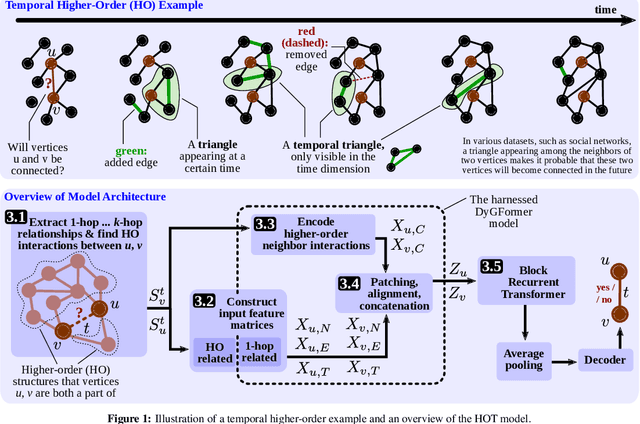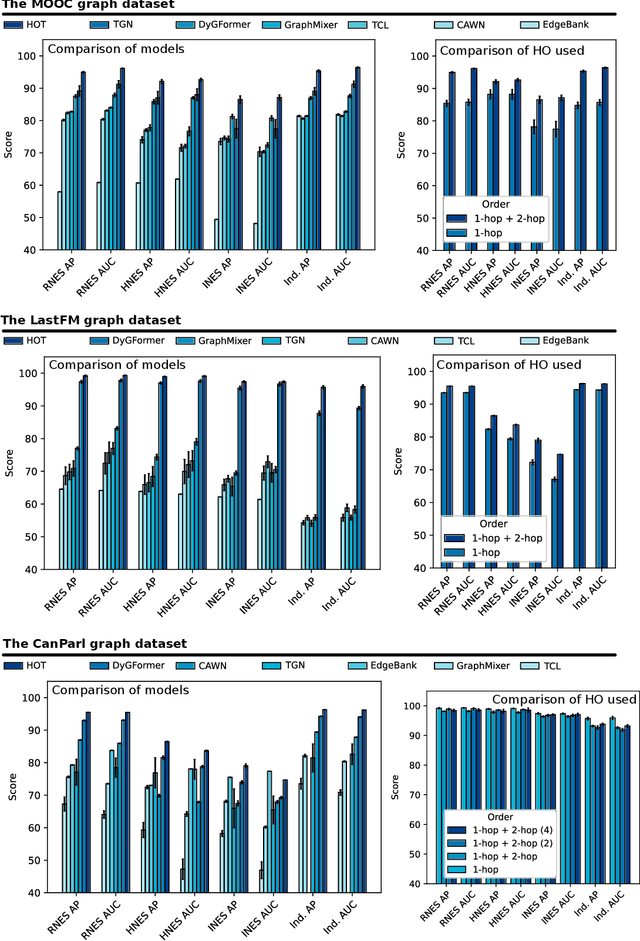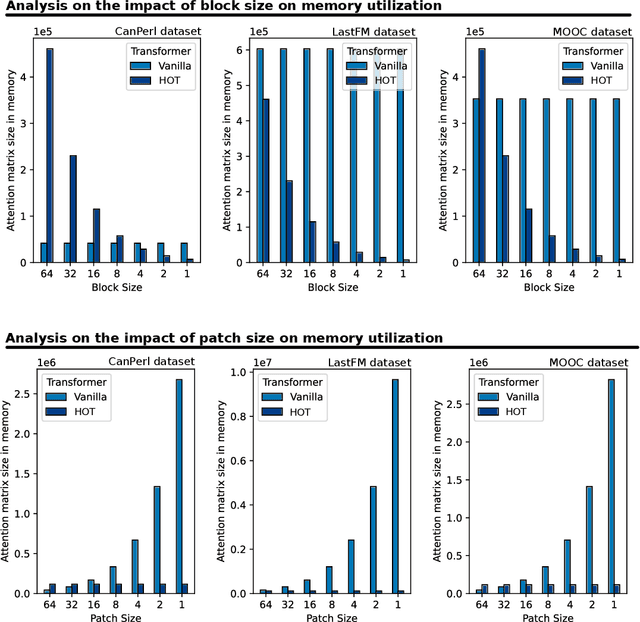Torsten Hoefler
Multi-Head RAG: Solving Multi-Aspect Problems with LLMs
Jun 07, 2024Abstract:Retrieval Augmented Generation (RAG) enhances the abilities of Large Language Models (LLMs) by enabling the retrieval of documents into the LLM context to provide more accurate and relevant responses. Existing RAG solutions do not focus on queries that may require fetching multiple documents with substantially different contents. Such queries occur frequently, but are challenging because the embeddings of these documents may be distant in the embedding space, making it hard to retrieve them all. This paper introduces Multi-Head RAG (MRAG), a novel scheme designed to address this gap with a simple yet powerful idea: leveraging activations of Transformer's multi-head attention layer, instead of the decoder layer, as keys for fetching multi-aspect documents. The driving motivation is that different attention heads can learn to capture different data aspects. Harnessing the corresponding activations results in embeddings that represent various facets of data items and queries, improving the retrieval accuracy for complex queries. We provide an evaluation methodology and metrics, synthetic datasets, and real-world use cases to demonstrate MRAG's effectiveness, showing improvements of up to 20% in relevance over standard RAG baselines. MRAG can be seamlessly integrated with existing RAG frameworks and benchmarking tools like RAGAS as well as different classes of data stores.
CheckEmbed: Effective Verification of LLM Solutions to Open-Ended Tasks
Jun 04, 2024



Abstract:Large Language Models (LLMs) are revolutionizing various domains, yet verifying their answers remains a significant challenge, especially for intricate open-ended tasks such as consolidation, summarization, and extraction of knowledge. In this work, we propose CheckEmbed: an accurate, scalable, and simple LLM verification approach. CheckEmbed is driven by a straightforward yet powerful idea: in order to compare LLM solutions to one another or to the ground-truth, compare their corresponding answer-level embeddings obtained with a model such as GPT Text Embedding Large. This reduces a complex textual answer to a single embedding, facilitating straightforward, fast, and meaningful verification. We develop a comprehensive verification pipeline implementing the CheckEmbed methodology. The CheckEmbed pipeline also comes with metrics for assessing the truthfulness of the LLM answers, such as embedding heatmaps and their summaries. We show how to use these metrics for deploying practical engines that decide whether an LLM answer is satisfactory or not. We apply the pipeline to real-world document analysis tasks, including term extraction and document summarization, showcasing significant improvements in accuracy, cost-effectiveness, and runtime performance compared to existing token-, sentence-, and fact-level schemes such as BERTScore or SelfCheckGPT.
QuaRot: Outlier-Free 4-Bit Inference in Rotated LLMs
Mar 30, 2024



Abstract:We introduce QuaRot, a new Quantization scheme based on Rotations, which is able to quantize LLMs end-to-end, including all weights, activations, and KV cache in 4 bits. QuaRot rotates LLMs in a way that removes outliers from the hidden state without changing the output, making quantization easier. This computational invariance is applied to the hidden state (residual) of the LLM, as well as to the activations of the feed-forward components, aspects of the attention mechanism and to the KV cache. The result is a quantized model where all matrix multiplications are performed in 4-bits, without any channels identified for retention in higher precision. Our quantized LLaMa2-70B model has losses of at most 0.29 WikiText-2 perplexity and retains 99% of the zero-shot performance. Code is available at: https://github.com/spcl/QuaRot.
SliceGPT: Compress Large Language Models by Deleting Rows and Columns
Jan 26, 2024



Abstract:Large language models have become the cornerstone of natural language processing, but their use comes with substantial costs in terms of compute and memory resources. Sparsification provides a solution to alleviate these resource constraints, and recent works have shown that trained models can be sparsified post-hoc. Existing sparsification techniques face challenges as they need additional data structures and offer constrained speedup with current hardware. In this paper we present SliceGPT, a new post-training sparsification scheme which replaces each weight matrix with a smaller (dense) matrix, reducing the embedding dimension of the network. Through extensive experimentation, we show that SliceGPT can remove up to 25% of the model parameters (including embeddings) for LLAMA2-70B, OPT 66B and Phi-2 models while maintaining 99%, 99% and 90% zero-shot task performance of the dense model respectively. Our sliced models run on fewer GPUs and run faster without any additional code optimization: on 24GB consumer GPUs we reduce the total compute for inference on LLAMA2-70B to 64% of that of the dense model; on 40GB A100 GPUs we reduce it to 66%. We offer a new insight, computational invariance in transformer networks, which enables SliceGPT and we hope it will inspire and enable future avenues to reduce memory and computation demands for pre-trained models. Code is available at: https://github.com/microsoft/TransformerCompression
Topologies of Reasoning: Demystifying Chains, Trees, and Graphs of Thoughts
Jan 25, 2024Abstract:The field of natural language processing (NLP) has witnessed significant progress in recent years, with a notable focus on improving large language models' (LLM) performance through innovative prompting techniques. Among these, prompt engineering coupled with structures has emerged as a promising paradigm, with designs such as Chain-of-Thought, Tree of Thoughts, or Graph of Thoughts, in which the overall LLM reasoning is guided by a structure such as a graph. As illustrated with numerous examples, this paradigm significantly enhances the LLM's capability to solve numerous tasks, ranging from logical or mathematical reasoning to planning or creative writing. To facilitate the understanding of this growing field and pave the way for future developments, we devise a general blueprint for effective and efficient LLM reasoning schemes. For this, we conduct an in-depth analysis of the prompt execution pipeline, clarifying and clearly defining different concepts. We then build the first taxonomy of structure-enhanced LLM reasoning schemes. We focus on identifying fundamental classes of harnessed structures, and we analyze the representations of these structures, algorithms executed with these structures, and many others. We refer to these structures as reasoning topologies, because their representation becomes to a degree spatial, as they are contained within the LLM context. Our study compares existing prompting schemes using the proposed taxonomy, discussing how certain design choices lead to different patterns in performance and cost. We also outline theoretical underpinnings, relationships between prompting and others parts of the LLM ecosystem such as knowledge bases, and the associated research challenges. Our work will help to advance future prompt engineering techniques.
Swing: Short-cutting Rings for Higher Bandwidth Allreduce
Jan 17, 2024Abstract:The allreduce collective operation accounts for a significant fraction of the runtime of workloads running on distributed systems. One factor determining its performance is the distance between communicating nodes, especially on networks like torus, where a higher distance implies multiple messages being forwarded on the same link, thus reducing the allreduce bandwidth. Torus networks are widely used on systems optimized for machine learning workloads (e.g., Google TPUs and Amazon Trainium devices), as well as on some of the Top500 supercomputers. To improve allreduce performance on torus networks we introduce Swing, a new algorithm that keeps a low distance between communicating nodes by swinging between torus directions. Our analysis and experimental evaluation show that Swing outperforms by up to 3x existing allreduce algorithms for vectors ranging from 32B to 128MiB, on different types of torus and torus-like topologies, regardless of their shape and size.
DiffDA: a diffusion model for weather-scale data assimilation
Jan 11, 2024Abstract:The generation of initial conditions via accurate data assimilation is crucial for reliable weather forecasting and climate modeling. We propose the DiffDA as a machine learning based data assimilation method capable of assimilating atmospheric variables using predicted states and sparse observations. We adapt the pretrained GraphCast weather forecast model as a denoising diffusion model. Our method applies two-phase conditioning: on the predicted state during both training and inference, and on sparse observations during inference only. As a byproduct, this strategy also enables the post-processing of predictions into the future, for which no observations are available.Through experiments based on a reanalysis dataset, we have verified that our method can produce assimilated global atmospheric data consistent with observations at 0.25degree resolution. The experiments also show that the initial conditions that are generated via our approach can be used for forecast models with a loss of lead time of at most 24 hours when compared to initial conditions of state-of-the-art data assimilation suites. This enables to apply the method to real world applications such as the creation of reanalysis datasets with autoregressive data assimilation.
How to Prune Your Language Model: Recovering Accuracy on the "Sparsity May Cry'' Benchmark
Dec 21, 2023Abstract:Pruning large language models (LLMs) from the BERT family has emerged as a standard compression benchmark, and several pruning methods have been proposed for this task. The recent ``Sparsity May Cry'' (SMC) benchmark put into question the validity of all existing methods, exhibiting a more complex setup where many known pruning methods appear to fail. We revisit the question of accurate BERT-pruning during fine-tuning on downstream datasets, and propose a set of general guidelines for successful pruning, even on the challenging SMC benchmark. First, we perform a cost-vs-benefits analysis of pruning model components, such as the embeddings and the classification head; second, we provide a simple-yet-general way of scaling training, sparsification and learning rate schedules relative to the desired target sparsity; finally, we investigate the importance of proper parametrization for Knowledge Distillation in the context of LLMs. Our simple insights lead to state-of-the-art results, both on classic BERT-pruning benchmarks, as well as on the SMC benchmark, showing that even classic gradual magnitude pruning (GMP) can yield competitive results, with the right approach.
HOT: Higher-Order Dynamic Graph Representation Learning with Efficient Transformers
Nov 30, 2023



Abstract:Many graph representation learning (GRL) problems are dynamic, with millions of edges added or removed per second. A fundamental workload in this setting is dynamic link prediction: using a history of graph updates to predict whether a given pair of vertices will become connected. Recent schemes for link prediction in such dynamic settings employ Transformers, modeling individual graph updates as single tokens. In this work, we propose HOT: a model that enhances this line of works by harnessing higher-order (HO) graph structures; specifically, k-hop neighbors and more general subgraphs containing a given pair of vertices. Harnessing such HO structures by encoding them into the attention matrix of the underlying Transformer results in higher accuracy of link prediction outcomes, but at the expense of increased memory pressure. To alleviate this, we resort to a recent class of schemes that impose hierarchy on the attention matrix, significantly reducing memory footprint. The final design offers a sweetspot between high accuracy and low memory utilization. HOT outperforms other dynamic GRL schemes, for example achieving 9%, 7%, and 15% higher accuracy than - respectively - DyGFormer, TGN, and GraphMixer, for the MOOC dataset. Our design can be seamlessly extended towards other dynamic GRL workloads.
Chameleon: a Heterogeneous and Disaggregated Accelerator System for Retrieval-Augmented Language Models
Oct 15, 2023



Abstract:A Retrieval-Augmented Language Model (RALM) augments a generative language model by retrieving context-specific knowledge from an external database. This strategy facilitates impressive text generation quality even with smaller models, thus reducing orders of magnitude of computational demands. However, RALMs introduce unique system design challenges due to (a) the diverse workload characteristics between LM inference and retrieval and (b) the various system requirements and bottlenecks for different RALM configurations such as model sizes, database sizes, and retrieval frequencies. We propose Chameleon, a heterogeneous accelerator system that integrates both LM and retrieval accelerators in a disaggregated architecture. The heterogeneity ensures efficient acceleration of both LM inference and retrieval, while the accelerator disaggregation enables the system to independently scale both types of accelerators to fulfill diverse RALM requirements. Our Chameleon prototype implements retrieval accelerators on FPGAs and assigns LM inference to GPUs, with a CPU server orchestrating these accelerators over the network. Compared to CPU-based and CPU-GPU vector search systems, Chameleon achieves up to 23.72x speedup and 26.2x energy efficiency. Evaluated on various RALMs, Chameleon exhibits up to 2.16x reduction in latency and 3.18x speedup in throughput compared to the hybrid CPU-GPU architecture. These promising results pave the way for bringing accelerator heterogeneity and disaggregation into future RALM systems.
 Add to Chrome
Add to Chrome Add to Firefox
Add to Firefox Add to Edge
Add to Edge